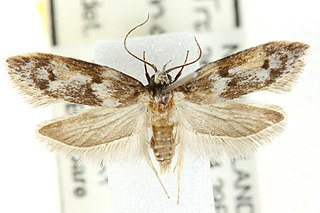
Epinotia tedella is a moth of the family Tortricidae. It is found in Europe.
Anarsia leucophora is a moth of the family Gelechiidae. It was described by Edward Meyrick in 1904. It is found in New South Wales.
Alloclita xylodesma is a moth in the family Cosmopterigidae. It was described by Edward Meyrick in 1911. It is found in South Africa.
Microcolona arizela is a moth in the family Elachistidae. It was described by Edward Meyrick in 1897. It is found in Australia, where it has been recorded from New South Wales and Tasmania.
Dichomeris ligyra is a species of moth in the family Gelechiidae. It was described by Edward Meyrick in 1913. It is found in Gauteng, South Africa.
Onebala amethystina is a moth in the family Gelechiidae. It was described by Edward Meyrick in 1904. It is found in Australia, where it has been recorded from New South Wales and Queensland.
Hypatima euplecta is a species of moth in the family Gelechiidae. It was described by Edward Meyrick in 1904. It is found in Australia, where it has been recorded from Queensland, New South Wales, Victoria and South Australia.
Hypatima isotricha is a species of moth in the family Gelechiidae. It was described by Edward Meyrick in 1921. It is found on Java in Indonesia.
Neotelphusa castrigera is a moth of the family Gelechiidae first described by Edward Meyrick in 1913. It is found in South Africa and Zimbabwe.
Ephysteris semiophanes is a moth in the family Gelechiidae. It was described by Edward Meyrick in 1918. It is found in Sri Lanka.
Compsolechia caryoterma is a moth of the family Gelechiidae. It was described by Edward Meyrick in 1922. It is found in Amazonas, Brazil.
Antaeotricha sparganota is a moth of the family Depressariidae first described by Edward Meyrick in 1915. It is found in Guyana.
Deltoplastis coercita is a moth in the family Lecithoceridae. It was described by Edward Meyrick in 1923. It is found in southern India.
Thymiatris arista is a moth in the family Xyloryctidae. It was described by Alexey Diakonoff in 1968. It is found on Luzon in the Philippines.
Antaeotricha phryactis is a moth in the family Depressariidae. It was described by Edward Meyrick in 1925. It is found in Peru and Brazil.
Antaeotricha sardania is a moth in the family Depressariidae. It was described by Edward Meyrick in 1925. It is found in Brazil (Para) and Peru.
Antaeotricha teleosema is a moth in the family Depressariidae. It was described by Edward Meyrick in 1925. It is found in Brazil.
Antaeotricha cyprodeta is a moth in the family Depressariidae. It was described by Edward Meyrick in 1930. It is found in Brazil.
Chlamydastis truncatula is a moth in the family Depressariidae. It was described by Edward Meyrick in 1913. It is found in Venezuela.

Trachypepla importuna is a moth of the family Oecophoridae first described by Edward Meyrick in 1927. This moth is regarded as having been introduced to New Zealand and is presumed to be native to Australia. T. importuna has been collected in both the North and South Islands of New Zealand. It inhabits native scrub and adults are on the wing in January and February. The placement of this species in the genus Trachypepla is regarded as being unsatisfactory and in need of revision.

